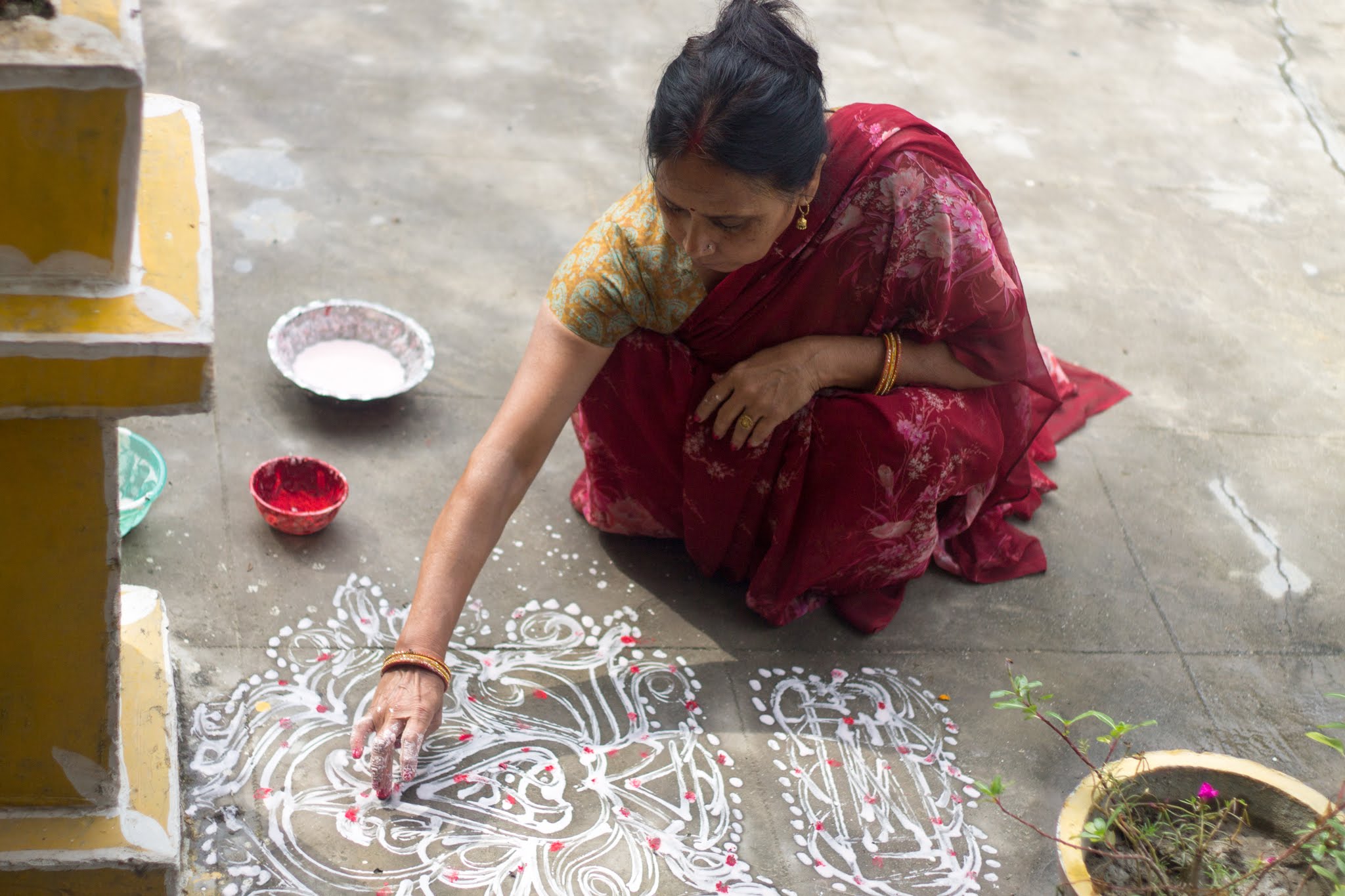Culture & Lifestyle
Here’s everything you need to know about mandalas for Tihar
Both Mithila and Newar cultures revere mandalas or aripanas during the festival, despite basic differences in the processes of making them and their interpretation.
Srizu Bajracharya & Sweksha Karna
The cities around the country have already embraced the colourful lights—both traditional butter lamps and the electrical ones. Tihar is here, also popularly known as the festival of lights. But Tihar has many names—Deepawali, Diwali, Sunthi, and Yamapanchak—and the methods of celebrations vary according to different regions and ethnicities. In Newar and Mithila communities, like the pervasive lights, mandalas are also a big part of the festival.
In the majority of the households, the festivities start at dusk. But before the worship bells start ringing and lights are illuminated, a lot of work is put behind the scenes. And in Newar and Mithila communities, mostly women engage in drawing mandalas, but they follow different methods and interpretations.
In both the communities, however, mandalas are a means to a religious and cultural accomplishment. They are an ever-present concept in almost every puja, fast or celebrations.
“Each religion has its own meaning of the mandala. In Buddhist philosophy, the mandala represents the principle and boundaries of life,” says Yagya Man Pati Bajracharya, a Buddhist scholar. “It explains how the universe functions.”
In Mithila culture, however, mandalas or aripanas were originally drawn during Tihar for decorative purposes, says Sharda Labh, an artist who specialises in Mithila art. “But over time, they became more religious and traditional,” she says.
In Newar culture
For Mha puja, which is observed on the fourth day of the festival, the mandala drawn during the ceremony represents the human body, which is the main theme of the festival: worship of the self.
Family members, particularly women, clean and rub earthen colour on the floor before an arrayed mat seating arrangement for the puja. They space out room for a number of mandalas that totals the members in the family.
In the beginning, a base is drawn using rice flour. While some families use it in its original form, some mix red or yellow powder to the flour. The designs are usually two triangles overlapped within a circle. Many also trace various designs with templates available in the market, but its significance is highlighted by the constituents inside the mandala rather than the design.
Regardless of the variation in the designs, the mandala should constitute tyah (parched rice), black soybean, unhusked rice, rato mas (black gram) and ankhey (unpolished rice), sequentially in five concentric circles.
Specifically, in Newar Buddhist culture, mandalas represent the relation of five senses—sight, sound, smell, taste and touch—with the mind, says Bajracharya. It manifests the universe within ourselves that functions because of the four elements of life: earth, water, air and fire.
It also represents the five celestial Buddhas: Vairochana, Akshobhya, Ratnasambhava, Amitabha, and Amoghasiddhi. This is interpreted for mandalas drawn during both Mha puja and Bhai Tika.
Some Hindu families during Mha Puja and Bhai Tika also make a mandala with five concentric circles with the potay (marble dust), sinah (red vermillion powder), dhaan (unhusked rice), flower and taa: (parched rice). However, here they worship the chakras says Abhas Rajopadhyaya, a cultural anthropologist.
But for Bhai Tika, the drawing of mandalas is also tied to the myth of a sister bargaining for her brother’s life with Yama, the god of death. At the centre of the mandala, a circle is made out of oil dipped wick. According to the legend, the sister had asked the god of death to wait until the oil dries, but the circle drawn over the dried red mud didn’t lose its presence, and hence, Yama had to leave empty-handed.
These interpretations make mandalas more interesting, although it is primarily transcribed as a way to understand the spirituality of one’s existence. Nowadays, people have also started using different colours to decorate mandalas, but regardless of how much effort and time is put into making them, the result rests in spoiling it at the end of puja—signifying the impermanence of all physical existence.
In Mithila culture
Unlike mandalas drawn in Newar culture that uses dry colours and various constituents inside it, aripanas are made from pithaar—a thin white paste made out of rice that has been soaked overnight. It usually comprises of line drawings, illustrated on the floor of the house, mostly at the entrance.

“We draw them with our hands and only use ring fingers, just how we use ring fingers during pujas,” says Labh, who has been teaching aripana drawing for more than 30 years now.
There are also a few things to keep in mind while making aripanas. All constructions should be double-lined, not single. “Everything is better in pairs, so no single lines are used,” says Labh.
Aripanas mostly consist of red, white and yellow colours, considered pure and auspicious in Hinduism. The base of all the colour is pithaar, which is white. To prepare the red colour, vermilion (sindoor) is added to pithaar and to obtain yellow colour, turmeric powder is mixed. It is also considered bad luck to see an aripana without sindoor, which is why sindoor is immediately added to the pattern once it’s made.
“Artificial colours weren’t available,” says Labh. “Also because these patterns were made by women, things that were easily available in the household like rice and turmeric were used to make aripana.”
In Tihar especially, three kinds of aripanas are made—Astadal Kamal, Laxmi Charan and Chumaan aripana. Astadal Kamal is a very simple illustration of an eight-petalled lotus. It can be made anytime, and anywhere.
“It is believed that Lord Vishnu sits on a lotus with eight petals. By drawing an Astadal Kamal, we are inviting him to come to our doorsteps,” says Sangita Jha, a housewife, who religiously draws aripanas every year during the festival.
Similarly, Laxmi Charan, which literally translates to Laxmi’s footsteps, is made to invite the goddess of wealth and prosperity into people’s abodes. Chumaan aripanas are made for ceremonies where elders bless the youngsters, and in Tihar, they are made for Bhai Tika. This aripana consists of a rectangular pattern which is used as seating, and a decorated betel leaf, with a crown called ‘murhi’, a tailed called ‘puchhi’ and a god in the centre.
“Betel leaf and pithaar are signs of prosperity and auspiciousness. So combining both of them in the form of aripana is like inviting both things home,” says Jha.
Except for religious significance, Labh believes that aripanas are also a way of showing respect to people and culture, “Making aripanas is a way of honouring our traditions. Besides that, aripanas are also a symbol of love and respect,” she says. “Welcoming people with an aripana on your courtyard or doorstep makes them feel like you’ve put in efforts for them and their visit.”
Although there are basic differences in these two cultures on the method of drawing mandalas, and their interpretations, both cultures take the sacredness of the drawing very seriously. They refrain from touching the mandalas with feet or sweeping with a broom. The mandalas can only be moped with a clean cloth and holy water, and are done so at least a day after they are drawn.




 9.12°C Kathmandu
9.12°C Kathmandu
















